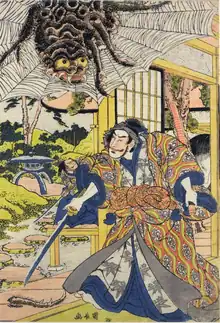Tsuchigumo (土蜘蛛, "Earth Spider") is a Japanese Noh play. The author is unknown.
Genre, authorship and date
Tsuchigumo is a Noh play.[1] More specifically, it is classified as a genzai Noh (現在能),[1] a relatively realistic work featuring human characters and taking place in a linear time line. It is a gobanme-mono (五番目物),[1] meaning that the Nihyakujū-ban Utai Mokuroku (二百拾番謡目録) indicates that its author is unknown.[1] In the modern era, it is part of the repertoires of all five of the major schools of Noh (五流現行曲).[1]
The story takes place in the Heian period of Japanese history, depicting a popular hero of that era—specifically the late 10th and early 11th centuries—taking down a monstrous spider, but the play itself dates to the significantly later Muromachi period (14th–16th centuries).[2]
Sources
The story is derived from Heike Tsuruginomaki.[1]
Cast of characters
- Minamoto no Raikō (tsure)[1]
- Kochō the Handmaiden (tsure)[1]
- A yōkai in the form of a monk (mae-shite)[1]
- A lone warrior (waki)[1]
- The tsuchigumo spirit (nochi-shite)[1]
Plot
Act I
The famed general Minamoto no Yorimitsu, also known as Raikō, is suffering from an illness of the body and mind, and is resting at his mansion. A handmaiden, Kochō (胡蝶, "Butterfly"), arrives with medicine from the court physician, and after comforting the general, she takes her leave. Raikō's sickness grows ever worse, when a malicious spirit, or yōkai, who has taken the form of a Buddhist monk, appears, and casts a large amount of spider webbing onto Raikō. Raikō, despite his illness, reaches for the well-renowned sword beside his pillow and cuts into the monster. At this point, the monster disappears.[1]
Act II

Hearing the noise, a solitary warrior rushes to the scene. Following the blood that has spilled from the yōkai, the young warrior eventually comes to an old gravesite. A tsuchigumo, or "earth-spider", spirit appears before him, and sprays him with vast quantities of webbing, causing him tremendous pain, but he ultimately wins out and strikes the spider down.[1]
Themes
The work has a relatively direct, "realistic" plot compared with other Noh plays,[1] and its emphasis on martial prowess was likely what earned it favour among the military class.[1]
Influence
The play provided the inspiration for numerous later works of the kabuki theatre,[1] including the tokiwazu piece Kumo no Ito Azusa no Yumihari (蜘蛛糸梓弦)[1] and the nagauta piece Waga Seko Koi no Aizuchi (我背子恋の合槌),[1] which is also called Kumo no Byōshi-mai (蜘蛛の拍子舞).[3] The latter work was first performed in 1781, and was part of a late 18th-century trend in kabuki where the actors would speak their lines while performing dances.[4]
References
Citations
Works cited
- "Hyōshi-mai" 拍子舞. 歌舞伎公式総合サイト 歌舞伎美人 (in Japanese). Shochiku. 2020. Retrieved 2020-10-18.
- "Tsuchigumo-zoku no Unmei: Nō Tsuchigumo no Shiten kara Kangaeru" 土蜘蛛族の運命 ─ 能〈土蜘蛛〉の視点から考える ─ (PDF). Musashino University website (in Japanese). Musashino University. 2020. Retrieved 2020-10-18.
- Tsukamoto, Yasuhiko [in Japanese] (1983). "Tsuchigumo". Nihon Koten Bungaku Daijiten 日本古典文学大辞典 (in Japanese). Vol. 4. Tokyo: Iwanami Shoten. p. 319. OCLC 11917421.